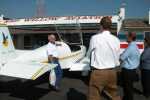'Sport' plane could be addictive

Point the nose down the runway, face the wind and add full power. Accelerate quickly to 50 knots and fly off the ground. Pitch the nose up to climb at 60 knots. Roll gently into and out of shallow turns to get the feel of this beautiful little airplane.
It was my first time off the ground in the prototype Light Sport Aircraft that Ron Willocks and Ken Daub are gearing up to build in their Clear Horizons shop right here in McCook.
The yet-unnamed airplane I flew was actually constructed from a kit by Ken. It is brand new, only forty hours on the clock. Ken had carefully gone over the airplane with me to explain what every control, lever, switch, button and bell did but declined to accompany my first flight.
Looking over the conventionally shaped airplane before flight, my impression was a good strong simple design carefully put together by a superb craftsman. The pilot fraternity has a saying that "if an airplane looks good, it will fly well." Ken's little airplane proved the point; it looks good and flies well, honest in every respect.
Most of the ultralight and homebuilt aircraft that I've been around use a 2-cycle engine for power just like the snowmobiles that I used to drive. Those engines run at high RPM and have to be geared down to turn the propeller at a reasonable speed. The result seems to be a lot of vibration and noise.
Not so for the Jabiru engine in the airplane Ken built. The Jabiru is a real air-cooled aircraft engine designed and built in Australia. It produces 85 horsepower, is smooth, quiet and a great match for the little 576 pound airplane that I flew.
Climbing to a safe altitude I did a couple of steep turns and a stall or two. No surprises there, it just burbles a bit and the nose bobs down at the stall, all perfectly safe and normal. I couldn't find a bad habit anywhere. Through the big clear canopy, visibility is simply wonderful.
Then back to the airport to explore how it lands. The recommended speed on final is 50 knots which seemed really slow from all my past experience in other aircraft, but this one felt solid and left plenty of energy to flare for a smooth touchdown.
I made two more takeoffs and landings to explore how it handled with flaps up and flaps down before I taxied back to the hangar wearing a grin from ear to ear.
The FAA recently created a new class of basic aircraft and relaxed the rules for the pilots who want to fly them. The aircraft are called "Light Sport Aircraft" and the pilots are termed "Sport Pilots."
As the names indicate, the goal is to make aviation affordable to more people, the ones who want to fly just for the fun of it. A big attraction for the Sport Pilot category is that a medical certificate is no longer required and all those already certificated pilots out there who have let their medicals expire are eligible.
All one has to do is produce a driver's license and make the self determination that "I feel good enough to fly today" and go do it! The Light Sport Aircraft have weight limitations, 1,320 pounds, and have seats for only two occupants.
Only a few companies are building them now and the ones I've seen advertised promise $100,000+ price tags. Ron and Ken think they can produce new airplanes here for a little over half that figure. If they can bring their dream to fruition, they should sell a lot of them.
I was thrilled to fly this great little airplane and excited that it will be manufactured, complete and ready to fly, right here in McCook, USofA.
